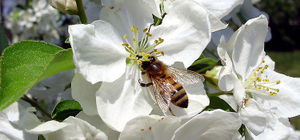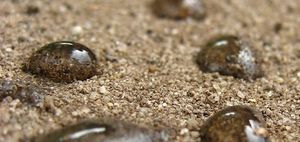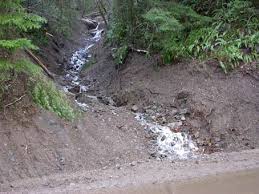Ecosystem Services: Difference between revisions
No edit summary |
m The LinkTitles extension automatically added links to existing pages (<a rel="nofollow" class="external free" href="https://github.com/bovender/LinkTitles">https://github.com/bovender/LinkTitles</a>). |
||
| (29 intermediate revisions by 2 users not shown) | |||
| Line 1: | Line 1: | ||
Ecosystem services are the many and varied benefits that humans freely gain from the natural environment and from properly-functioning ecosystems. | [[Ecosystem services]] are the many and varied benefits that humans freely gain from the natural environment and from properly-functioning ecosystems. | ||
[[File:apple.jpg|300px|thumb|right|Pollination is one type of ecosystem service]] | [[File:apple.jpg|300px|thumb|right|Pollination is one type of ecosystem service [6]]] | ||
== Denfinition == | == Denfinition == | ||
Per the 2006 Millennium Ecosystem Assessment (MA), ecosystem services are "the benefits people obtain from ecosystems". | Per the 2006 Millennium Ecosystem Assessment (MA), ecosystem services are "the benefits people obtain from ecosystems". These benefits may be as broad as the oxygen we breathe to the simple joy one experiences when walking past a garden. Because they are so broad and overlapping, the term "ecosystem services" has been defined into select categories to further describe which particular ecosystems or habitats provide which service. While a small garden may produce oxygen, the services yielded by such a small system would likely come from the foods produced and thereby consumed, rather than the minute amount of oxygen a few garden plants produce. [1] | ||
== Four categories == | == Four categories == | ||
The Millennium Ecosystem Assessment (MA) report 2005 defines Ecosystem services as benefits people obtain from ecosystems and distinguishes four categories of ecosystem services, where the so-called supporting services are regarded as the basis for the services of the other three categories.The more details about the four services shows in [[Essential ecosystem services]]. | The Millennium Ecosystem Assessment (MA) report 2005 defines Ecosystem services as benefits people obtain from ecosystems and distinguishes four categories of ecosystem services, where the so-called supporting services are regarded as the basis for the services of the other three categories.The more details about the four services shows in [[Essential ecosystem services]]. | ||
These services are known as Supporting services, Provisioning services, Regulating services and Cultural services [1] | |||
=== Supporting services === | === Supporting services === | ||
These services include, but are not limited to, [[Nutrient Cycling]], primary production, [[soil]] formation, habitat provision and pollination. Each of these services may not directly contribute to benefit by humans, but instead are the foundation of most if not all other services. These services are generally the hardest to notice and appreciate, and as such are often neglected when considering the value of an ecosystem as a whole. [1] | |||
=== Provisioning services === | === Provisioning services === | ||
:Food, Materials, Water, Energy... | :-Food | ||
Humans consume primarily organic materials for metabolic activity. The pollination of crops by bees is required for 15-30% of U.S. food production alone. [1] More than one billion people worldwide rely on fish as their main source of animal protein, and in 2000 fisheries accounted for 12 percent of world food production.[5] | |||
:-Materials | |||
Marine creatures provide numerous raw materials for things such as dyes, clothing, lime extracted from corals for building, or deep sea gas pockets. Biochemicals extracted from marine [[organisms]] have unique [[properties]] for pharmaceuticals, cosmetics and numerous other products.[1] | |||
:-Water | |||
Humans rely on water for a myriad of activities other than simply just drinking. Food must be grown and cooked with it, nearly everything is washed with it, and nearly every manufacturing process from cars to cosmetics requires the use of clean water at some point. Ecosystems are responsible for the purification of nearly all water humans use. New York City at one point had water lower than the standards required by the[[File:Water-droplet.jpg|300px|thumb|right|[9]]] U. S. Environmental Protection Agency, and needed a system to purify it. Instead of building a costly water filtration plant, which would also need to be operated and maintained, the city instead opted to restore the Catskill Watershed to its previous environmental standard, which provided clean water through the processes of natural soil absorption and filtration. Because the sewage and pesticides were no longer being dumped into the watershed, several million people suddenly had cheap access to clean water.[2] | |||
:-Energy | |||
While most renewable energy comes from abiotic factors such as the sun, wind and tide, most energy consumed in this decade comes from fossil fuels. Ancient ecosystems rich in plants were killed and buried in a rapid process, and as a result we now enjoy high energy liquid, solid, and gaseous resources right under our feet. These sources of energy are the result of ancient ecosystems.[1] | |||
=== Regulating services === | === Regulating services === | ||
: | |||
: | :-Climate regulation | ||
: | The elements of aquatic and marine ecosystems are the largest portion of the climate regulation process. Marine [[microorganisms]] consume the largest portion of carbon dioxide on the planet, vastly outpacing any terrestrial plant population. In addition to sequestering massive amounts of carbon, aquatic organisms release the largest proportion of oxygen into the atmosphere of any organism on earth. [1] | ||
:-Waste [[decomposition]] | |||
The treatment of wastes is another massive regulation of marine systems. Wastes can be both diluted and detoxified through the many exchanges nutrients make through their time in an ecosystem. Pollutants are removed from an environment through the eventual processes of microbes, or by natural exposure to oxygen and sunlight. Complex toxic compounds, after enough time, eventually are broken down into their more basic components and eventually reabsorbed as nutrients in a system.[1] | |||
:-Shelter | |||
In addition to being the literal components we make shelters from, different ecosystems provide shelter from natural events by virtue of their existence. Coastal ecosystems provide shelter from natural hazards and disturbances. Wetlands and their related vegetation absorb lots of water from sudden floods and storms, and then slowly release it as a more gentle and manageable process. These coastal forests and shoreline communities prevent erosion that can eventually upend and damage structures.[8][[File:WaterErosion.jpg|300px|thumb|right|[10]]] | |||
=== Cultural services === | === Cultural services === | ||
: | :-Recreation and tourism | ||
Sea sports are extremely popular within coastal ecosystems. Surfing, boating, fishing and swimming are all activities that could not be possible without a properly maintained marine or aquatic habitat. Hiking, biking and camping are also extremely popular activities which rely on the use of large expanses of ecosystems for their attractiveness.[1] | |||
== References == | |||
[1]Millennium Ecosystem Assessment, 2005. Ecosystems and Human Well-being: Synthesis. | |||
Island Press, Washington, DC. URL https://www.millenniumassessment.org/documents/document.356.aspx.pdf | |||
[2]"Conservation of ecosystem services". Adam Purcell. Archived from the original on 29 November 2014 URL https://web.archive.org/web/20141129194450/http://basicbiology.net/biology/conservation/ecosystem_services.php | |||
[3]Raudsepp-Hearne, C. et al. 2010. Untangling the Environmentalist's Paradox: Why is Human Well-being Increasing as Ecosystem Services Degrade? Bioscience 60(8) 576–589. URL https://academic.oup.com/bioscience/article/60/8/576/304804 | |||
[4]Ostrom, E. 1990. Governing the Commons: The Evolution of Institutions for Collective Action. Cambridge University Press, Cambridge. URL https://wtf.tw/ref/ostrom_1990.pdf | |||
[5] Michelle Molnar, Cathryn Clarke-Murray, John Whitworth, and Jordan Tam. Marine and Coastal Ecosystem Services URL https://davidsuzuki.org/wp-content/uploads/2009/02/marine-coastal-ecosystem-services-pacific-north-coast-integrated-management-area-british-columbia.pdf | |||
[6]Apple Pollination Groups - Choosing Compatible Trees [WWW Document], n.d. [WWW Document]. GrowVeg. URL https://www.growveg.com/guides/apple-pollination-groups-choosing-compatible-trees/ (accessed 5.3.19). | |||
[7]Nutrient Cycles: Recycling in Ecosystems, The Carbon and Nitrogen Cycles [WWW Document], n.d. [WWW Document]. ScienceAid. URL https://scienceaid.net/biology/ecology/nutrient.html (accessed 5.3.19). | |||
[8]C., A.C., Hernández, M.E., Moreno-Casasola, P., Espinosa, E.C., R., A.R., Mata, D.I., 2011. Soil water retention and carbon pools in tropical forested wetlands and marshes of the Gulf of Mexico. Hydrological Sciences Journal 56, 1388–1406. doi:10.1080/02626667.2011.629786 | |||
[9]The Benefits of An Early Surfactant Application [WWW Document], 2019. [WWW Document]. Aquatrols Blog. URL https://blog.aquatrols.com/benefits-early-spring-surfactant/ (accessed 5.7.19). | |||
[10]Eatherington, F., 2008. Plum Creek Logging and [[soil erosion]]. URL https://www.flickr.com/photos/umpquawild/2514313759 | |||
Latest revision as of 12:04, 29 April 2021
Ecosystem services are the many and varied benefits that humans freely gain from the natural environment and from properly-functioning ecosystems.

Denfinition
Per the 2006 Millennium Ecosystem Assessment (MA), ecosystem services are "the benefits people obtain from ecosystems". These benefits may be as broad as the oxygen we breathe to the simple joy one experiences when walking past a garden. Because they are so broad and overlapping, the term "ecosystem services" has been defined into select categories to further describe which particular ecosystems or habitats provide which service. While a small garden may produce oxygen, the services yielded by such a small system would likely come from the foods produced and thereby consumed, rather than the minute amount of oxygen a few garden plants produce. [1]
Four categories
The Millennium Ecosystem Assessment (MA) report 2005 defines Ecosystem services as benefits people obtain from ecosystems and distinguishes four categories of ecosystem services, where the so-called supporting services are regarded as the basis for the services of the other three categories.The more details about the four services shows in Essential ecosystem services. These services are known as Supporting services, Provisioning services, Regulating services and Cultural services [1]
Supporting services
These services include, but are not limited to, Nutrient Cycling, primary production, soil formation, habitat provision and pollination. Each of these services may not directly contribute to benefit by humans, but instead are the foundation of most if not all other services. These services are generally the hardest to notice and appreciate, and as such are often neglected when considering the value of an ecosystem as a whole. [1]
Provisioning services
- -Food
Humans consume primarily organic materials for metabolic activity. The pollination of crops by bees is required for 15-30% of U.S. food production alone. [1] More than one billion people worldwide rely on fish as their main source of animal protein, and in 2000 fisheries accounted for 12 percent of world food production.[5]
- -Materials
Marine creatures provide numerous raw materials for things such as dyes, clothing, lime extracted from corals for building, or deep sea gas pockets. Biochemicals extracted from marine organisms have unique properties for pharmaceuticals, cosmetics and numerous other products.[1]
- -Water
Humans rely on water for a myriad of activities other than simply just drinking. Food must be grown and cooked with it, nearly everything is washed with it, and nearly every manufacturing process from cars to cosmetics requires the use of clean water at some point. Ecosystems are responsible for the purification of nearly all water humans use. New York City at one point had water lower than the standards required by the

U. S. Environmental Protection Agency, and needed a system to purify it. Instead of building a costly water filtration plant, which would also need to be operated and maintained, the city instead opted to restore the Catskill Watershed to its previous environmental standard, which provided clean water through the processes of natural soil absorption and filtration. Because the sewage and pesticides were no longer being dumped into the watershed, several million people suddenly had cheap access to clean water.[2]
- -Energy
While most renewable energy comes from abiotic factors such as the sun, wind and tide, most energy consumed in this decade comes from fossil fuels. Ancient ecosystems rich in plants were killed and buried in a rapid process, and as a result we now enjoy high energy liquid, solid, and gaseous resources right under our feet. These sources of energy are the result of ancient ecosystems.[1]
Regulating services
- -Climate regulation
The elements of aquatic and marine ecosystems are the largest portion of the climate regulation process. Marine microorganisms consume the largest portion of carbon dioxide on the planet, vastly outpacing any terrestrial plant population. In addition to sequestering massive amounts of carbon, aquatic organisms release the largest proportion of oxygen into the atmosphere of any organism on earth. [1]
- -Waste decomposition
The treatment of wastes is another massive regulation of marine systems. Wastes can be both diluted and detoxified through the many exchanges nutrients make through their time in an ecosystem. Pollutants are removed from an environment through the eventual processes of microbes, or by natural exposure to oxygen and sunlight. Complex toxic compounds, after enough time, eventually are broken down into their more basic components and eventually reabsorbed as nutrients in a system.[1]
- -Shelter
In addition to being the literal components we make shelters from, different ecosystems provide shelter from natural events by virtue of their existence. Coastal ecosystems provide shelter from natural hazards and disturbances. Wetlands and their related vegetation absorb lots of water from sudden floods and storms, and then slowly release it as a more gentle and manageable process. These coastal forests and shoreline communities prevent erosion that can eventually upend and damage structures.[8]

Cultural services
- -Recreation and tourism
Sea sports are extremely popular within coastal ecosystems. Surfing, boating, fishing and swimming are all activities that could not be possible without a properly maintained marine or aquatic habitat. Hiking, biking and camping are also extremely popular activities which rely on the use of large expanses of ecosystems for their attractiveness.[1]
References
[1]Millennium Ecosystem Assessment, 2005. Ecosystems and Human Well-being: Synthesis. Island Press, Washington, DC. URL https://www.millenniumassessment.org/documents/document.356.aspx.pdf
[2]"Conservation of ecosystem services". Adam Purcell. Archived from the original on 29 November 2014 URL https://web.archive.org/web/20141129194450/http://basicbiology.net/biology/conservation/ecosystem_services.php
[3]Raudsepp-Hearne, C. et al. 2010. Untangling the Environmentalist's Paradox: Why is Human Well-being Increasing as Ecosystem Services Degrade? Bioscience 60(8) 576–589. URL https://academic.oup.com/bioscience/article/60/8/576/304804
[4]Ostrom, E. 1990. Governing the Commons: The Evolution of Institutions for Collective Action. Cambridge University Press, Cambridge. URL https://wtf.tw/ref/ostrom_1990.pdf
[5] Michelle Molnar, Cathryn Clarke-Murray, John Whitworth, and Jordan Tam. Marine and Coastal Ecosystem Services URL https://davidsuzuki.org/wp-content/uploads/2009/02/marine-coastal-ecosystem-services-pacific-north-coast-integrated-management-area-british-columbia.pdf
[6]Apple Pollination Groups - Choosing Compatible Trees [WWW Document], n.d. [WWW Document]. GrowVeg. URL https://www.growveg.com/guides/apple-pollination-groups-choosing-compatible-trees/ (accessed 5.3.19).
[7]Nutrient Cycles: Recycling in Ecosystems, The Carbon and Nitrogen Cycles [WWW Document], n.d. [WWW Document]. ScienceAid. URL https://scienceaid.net/biology/ecology/nutrient.html (accessed 5.3.19).
[8]C., A.C., Hernández, M.E., Moreno-Casasola, P., Espinosa, E.C., R., A.R., Mata, D.I., 2011. Soil water retention and carbon pools in tropical forested wetlands and marshes of the Gulf of Mexico. Hydrological Sciences Journal 56, 1388–1406. doi:10.1080/02626667.2011.629786
[9]The Benefits of An Early Surfactant Application [WWW Document], 2019. [WWW Document]. Aquatrols Blog. URL https://blog.aquatrols.com/benefits-early-spring-surfactant/ (accessed 5.7.19).
[10]Eatherington, F., 2008. Plum Creek Logging and soil erosion. URL https://www.flickr.com/photos/umpquawild/2514313759